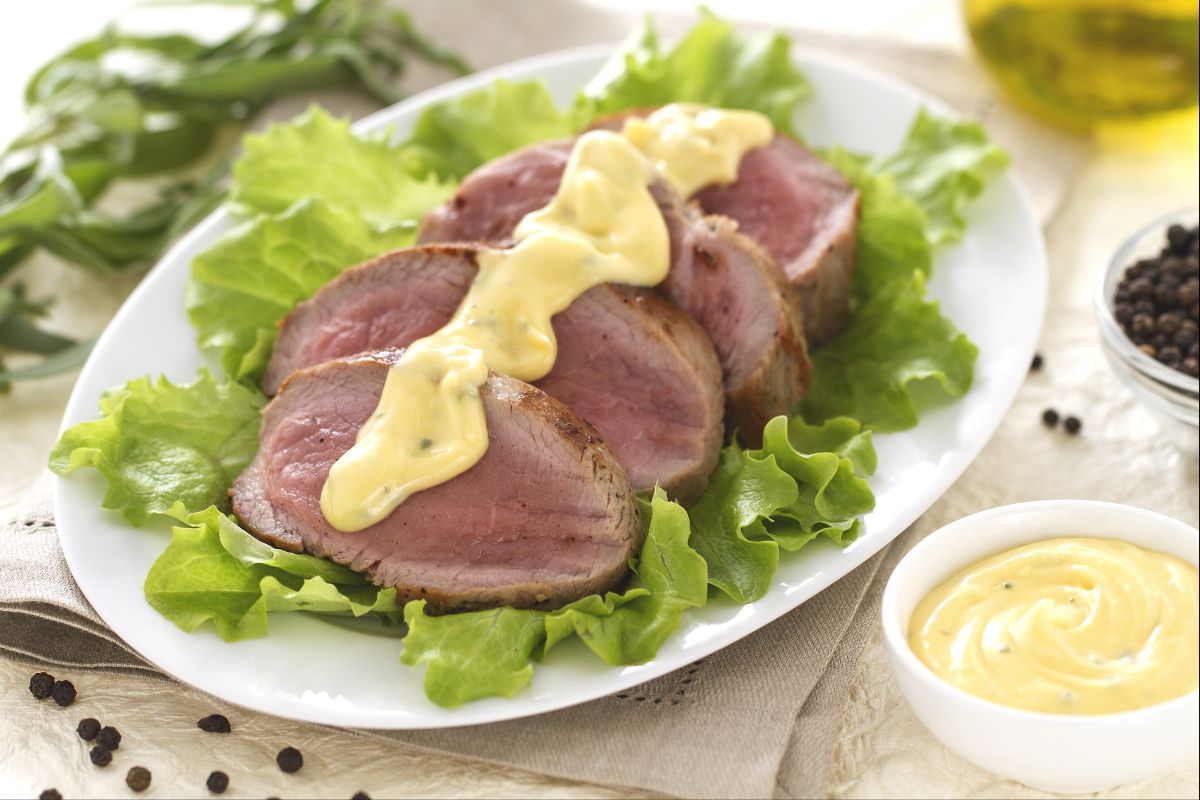Bearnaise sauce
- Average
- 35 min
- Kcal 466

Chateaubriand is like, really a true star of French cuisine. It makes any meal feel unique—like super special—with its rich heritage and elegant presentation. I mean, this dish has the finest cut from the beef tenderloin, right from the center. Seriously good. It’s considered a showstopper in France, especially on those special occasions. You get this crispy, caramelized crust on the outside with a tender, rare center. So so tender. You know there's been a lot of care in the cooking process.
Typically, the meat is marinated with olive oil, salt, and pepper. And look, then it's cooked in butter to get those deep, golden flavors. Really important. Traditionally served with potatoes, the dish gets even fancier with salsa bernesa—that famous French béarnaise sauce. Loved for its creamy texture and delicate tarragon flavor, it complements the beef perfectly. And you know what? If you're dining at a French restaurant, this dish often appears alongside classics like soupe à l’oignon and tarte tatin. No question, it's a special occasion.
What makes this receta de Chateaubriand special is really the meticulous attention to detail. French chefs take pride in ensuring the meat is cooked evenly—pretty much perfect every time—achieving that moist and juicy interior that just melts in your mouth. The harmony with filete de ternera con salsa bernesa is all about balance: the richness of the beef is complemented by the sauce's silky and slightly tangy profile, thanks to the vinegar and herbs.
When people talk about cómo hacer salsa bernesa, it’s all about the skill required to nail that smooth emulsion. It’s kinda like proof you know your way around a great sauce. Serving this dish with classic French sides? It's a celebration of cocina francesa clásica. Whether you're marking a special event or just want to elevate your dinner game, this dish never fails to impress. Seriously, it’s more than just a meal; it’s a delicious journey into the heart of French culinary tradition.
You might also like:

To prepare the chateaubriand with béarnaise sauce, first take the piece of beef and trim it as needed 1; you can also ask your trusted butcher to perform this operation. Place the chateaubriand in a large baking dish and coat it with extra virgin olive oil 2; then add some salt 3 and

pepper 4 then massage the meat so that it is evenly covered with the seasonings 5. Cover the baking dish with plastic wrap and let the chateaubriand marinate in the refrigerator for a couple of hours 6.

While the meat rests, prepare the béarnaise sauce (here is the detailed recipe): in a saucepan, pour the water, white wine, and vinegar, season with white pepper and salt, and add the shallot and half of the chopped tarragon 7. Bring the mixture to a boil, lower the heat, and cook until reduced to a third; then cool the infusion and strain the liquids through a sieve 8. In a bowl, place the 4 egg yolks and start whisking them with a hand whisk or electric mixer, gradually incorporating the infusion 9.

When the mixture is frothy, place the bowl over a pot of boiling water, cooking the sauce in a double boiler, and now pour the warm clarified butter into the yolk mixture 10 and continue whisking until you obtain a smooth, soft, and homogeneous mixture, similar to the consistency of zabaglione, which, when poured, forms ribbons. Remove the sauce from the heat and transfer it to a bowl; adjust with salt, pepper, and add, if desired, a few drops of lemon juice and finally the remaining tarragon 16. Stir to combine all the flavors, and the béarnaise sauce will be ready 18. Keep it warm with a sheet of plastic wrap in contact.

Now take back the chateaubriand: in a large non-stick pan, melt the butter (you can also use clarified butter), and when it is very hot, place the filet 13 and cook it quickly over high heat on both sides to prevent the juices from escaping, then turn the meat 14. When a nice golden crust has formed on the outside, continue cooking for another 5-8 minutes, basting the filet with the melted butter 15. The chateaubriand must be well-cooked on the outside while remaining tender and rare on the inside: the cooking should be quick, about 10-15 minutes.

Turn off the heat and let the meat rest so the juices can redistribute inside 16. Now all that remains is to slice the filet with a sharp meat knife, obtaining slices about 1/2 inch thick 17 and placing the chateaubriand on a serving plate over a bed of fresh greens! Your chateaubriand is ready to be served: place the béarnaise sauce directly over the meat 18 or serve it in a separate bowl.